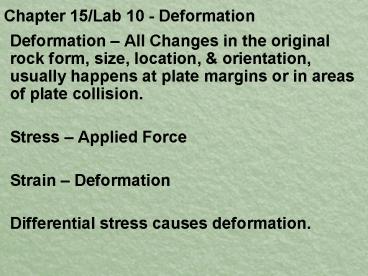Chapter 15Lab 10 Deformation - PowerPoint PPT Presentation
1 / 18
Title:
Chapter 15Lab 10 Deformation
Description:
... doesn't tell us whether the tilted rocks are part of an anticline or a syncline. ... Syncline limbs dip toward axial plane. Axial planes. Oldest in core of fold ... – PowerPoint PPT presentation
Number of Views:105
Avg rating:3.0/5.0
Title: Chapter 15Lab 10 Deformation
1
Chapter 15/Lab 10 - Deformation
- Deformation All Changes in the original rock
form, size, location, orientation, usually
happens at plate margins or in areas of plate
collision. - Stress Applied Force
- Strain Deformation
- Differential stress causes deformation.
2
2
Part of the task of assessing the geologic
history of an area is recording and describing
how rocks have been deformed.
3
3
In order to access the structural geology, we
need a geologic map showing surface distributions
of particular, mappable rock units. We define
Formations on the basis of color, texture,
composition and relation-ships with adjacent rock
units (types of contacts). Formations may be
subdivided into members. Geologic maps are
usually done on a topographic base map, so we can
see possible relationships between rock type and
topography.
4
4
In order to visualize subsurface
relation-ships, we need geologic cross-sections
constructed from well data and/or down-ward
projections of surface features (rock
orientations, fracture zones, fault zones,
tabular intrusions, etc.). Rock orientations are
measured using strike and dip meaurements of
bedding surfaces or foliations. Taking a strike
dip at the site of the river tunnel alone
doesnt tell us whether the tilted rocks are part
of an anticline or a syncline. Other
measure-ments are needed.
5
Types of Strain
5
- Compressional
Tensional
Shear
6
6
- Styles of Deformation
- Brittle Faults, Fractures, Joints
- Near surface, low temperature, low confining
pressure. - Ductile Anticlines, Synclines, Monoclines
- Deeper, higher temperature, higher confining
pressure.
7
Tensional strain Brittle deformation
possible setting continental rift vertical
shift
7
Hanging wall drops
High angle Normal fault
8
Compressional strain Brittle deformation
possible setting continental collision
vertical shift
8
Hanging wall rises
High angle Reverse fault
9
Compressional strain Ductile deformation
Possible setting continental collision
9
Anticlines Limbs dip away from axial
plane. Synclines Limbs dip toward axial plane.
Axial planes
Anticline
Youngest
Limbs
Limb
Oldest
Syncline
When the limbs dip at the same angle in relation
to the axial plane, they are symmetrical.
10
Compressional strain Brittle deformation
10
Possible setting continental collision
Low angle Reverse fault Thrust fault One sheet
ramps up over another.
Examples Alps, Appalachians, Juarez Mts.,
Mexico, Andes
11
Strike and Dip Measurements page 425
11
Dip angle of downward inclination at right
angle to strike orientation
300
Strike Compass orientation of horizontal line
super-imposed on tilted rock surface.
Intersection of two planes a line
12
Strike Dip measurement tips Using compass,
first find North and use a point of reference (a
local landmark) to remember. Slowly rotate to
the east or west (from your north reference) and
hold a flat, bottom edge of the compass against
the rock flat surface and take the degree reading
in relation to North, e.g., North 400 West.
After you determine the strike angle, determine
the dip angle.
13
Compressional strain Ductile deformation
13
Eroded Dome Beds dip away from center
Oldest
Youngest
14
Compressional strain Ductile deformation
14
Eroded basin Beds dip toward center
Youngest
Oldest
15
Brittle deformation joints and fractures
joints may be in parallel sets and flat,
fractures are more irregular.
15
Campus andesite UT El Paso
16
Map views of eroded anticlines and synclines
16
Axial planes
Oldest in core of fold
Youngest in core of fold
Syncline limbs dip toward axial plane
Anticline limbs dip away from axial plane
17
Strike slip fault Map view of horizontal
movement May be associated with trans-form
fault zone
17
Opposite side of fault moves to observers right
Right lateral
Observer
X
Opposite side of fault moves to observers left
Left lateral
X
Observer
18
(No Transcript)































